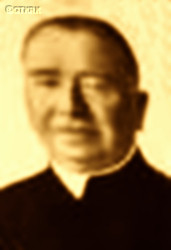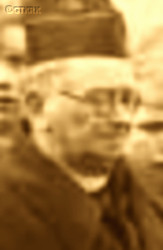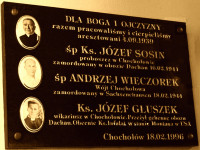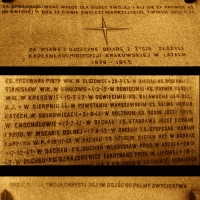Roman Catholic
St Sigismund parish
05-507 Słomczyn
85 Wiślana Str.
Konstancin deanery
Warsaw archdiocese, Poland
full list:
displayClick to display full list

searchClick to search full list by categories
wyświetlKliknij by wyświetlić pełną listę po polsku

szukajKliknij by przeszukać listę wg kategorii po polsku

Martyrology of the clergy — Poland
XX century (1914 – 1989)
personal data
surname
SOSIN
forename(s)
Joseph (pl. Józef)
function
diocesan priest
creed
Latin (Roman Catholic) Church RCmore on
en.wikipedia.org
[access: 2014.09.21]
diocese / province
Cracow archdiocesemore on
en.wikipedia.org
[access: 2013.05.19]
date and place
of death
16.02.1941

KL Dachauconcentration camp
today: Dachau, Upper Bavaria reg., Bavaria state, Germany
more on
en.wikipedia.org
[access: 2016.05.30]
alt. dates and places
of death
17.02.1942
details of death
After German and Slovak invasion of Poland on 01.09.1939 (Russians invaded Poland 17 days later) and start of the World War II, after start of Slovak occupation of Zakopane and vicinity, arrested by the Slovaks on 04.09.1939 together with his vicar and few days later (on c. 08.09.1939) handed over to the Germans who took reigns of power.
Held in various prisons, among others in Zakopane in „Palace” jail where was tortured.
On 19.06.1940 transported to KL Dachau concentration camp where was murdered: shot.
According to the death certificate, prepared in KL Dachau, the „honest” otherwise German „medical doctors” and formalists — and at the same time, unrivaled fairy tale spinners — noted that the cause of death was Germ. „Versagen von Herz und Kreislauf” (Eng. „Heart and circulatory failure”).
prisoner camp's numbers
13918Click to display source page (KL DachauClick to display the description)
cause of death
murder
perpetrators
Germans
sites and events
KL DachauClick to display the description, Zakopane (Palace)Click to display the description, «Intelligenzaktion»Click to display the description, Ribbentrop‐MolotovClick to display the description, Pius XI's encyclicalsClick to display the description
date and place
of birth
01.02.1879

Sygneczówtoday: Wieliczka gm., Wieliczka pov., Lesser Poland voiv., Poland
more on
en.wikipedia.org
[access: 2021.12.18]
parents
SOSIN John
🞲 ?, ? — 🕆 ?, ?

BATKO Mary
🞲 ?, ? — 🕆 ?, ?
presbyter (holy orders)
ordination
03.07.1904

positions held
c. 1938 – 1939
administrator — Chochołówtoday: Czarny Dunajec gm., Nowy Targ pov., Lesser Poland voiv., Poland
more on
en.wikipedia.org
[access: 2021.12.18] ⋄ St Jack the Confessor RC parish ⋄ Orawadeanery name
today: Lesser Poland voiv., Poland RC deanery
c. 1929 – c. 1937
resident — Chochołówtoday: Czarny Dunajec gm., Nowy Targ pov., Lesser Poland voiv., Poland
more on
en.wikipedia.org
[access: 2021.12.18] ⋄ St Jack the Confessor RC parish ⋄ Orawadeanery name
today: Lesser Poland voiv., Poland RC deanery
c. 1920 – c. 1926
prefect — Krakówtoday: Kraków city pov., Lesser Poland voiv., Poland
more on
en.wikipedia.org
[access: 2021.06.07] ⋄ Thaddeus Kościuszko Public School dor Men / Faculty School for Men
c. 1908 – c. 1918
prefect — Jaworznotoday: Jaworzno city pov., Silesia voiv., Poland
more on
en.wikipedia.org
[access: 2021.04.01] ⋄ St Adalbert the Bishop and Martyr and St Catherine Virgin and Martyr RC parish ⋄ Nowa Góratoday: Krzeszowice gm., Kraków pov., Lesser Poland voiv., Poland
more on
en.wikipedia.org
[access: 2021.06.07] RC deanery
1905 – 1907
vicar — Jaworznotoday: Jaworzno city pov., Silesia voiv., Poland
more on
en.wikipedia.org
[access: 2021.04.01] ⋄ St Adalbert the Bishop and Martyr and St Catherine Virgin and Martyr RC parish ⋄ Nowa Góratoday: Krzeszowice gm., Kraków pov., Lesser Poland voiv., Poland
more on
en.wikipedia.org
[access: 2021.06.07] RC deanery
till 1904
student — Krakówtoday: Kraków city pov., Lesser Poland voiv., Poland
more on
en.wikipedia.org
[access: 2021.06.07] ⋄ philosophy and theology, Theological Seminary ⋄ Kraków RC archdiocese
others related
in death
BUKOWSKIClick to display biography Leopold, DAŃKOWSKIClick to display biography Peter Edward, DROŹDZIKClick to display biography Peter, PRZYWARAClick to display biography Peter, ROZMUSClick to display biography Vincent, STASZEWSKAClick to display biography Helen (Sr Mary Clementa), SZEMBEKClick to display biography Francis Vladimir, SZOTTClick to display biography Francis Michael
sites and events
descriptions
KL Dachau: KL Dachau in German Bavaria, set up in 1933, became the main German Germ. Konzentrationslager (Eng. concentration camp) KL for Catholic priests and religious during World War II: On c. 09.11.1940, Reichsführer‐SS Heinrich Himmler, head of the SS, Gestapo and German police, as a result of the Vatican's intervention, decided to transfer all clergymen detained in various concentration camps to KL Dachau camp. The first major transports took place on 08.12.1940. In KL Dachau Germans held approx. 3,000 priests, including 1,800 Poles. The priests were forced to slave labor in the Germ. „Die Plantage” — the largest herb garden in Europe, managed by the genocidal SS, consisting of many greenhouses, laboratory buildings and arable land, where experiments with new natural medicines were conducted — for many hours, without breaks, without protective clothing, no food. They slaved in construction, e.g. of camp's crematorium. In the barracks ruled hunger, freezing cold in the winter and suffocating heat during the summer, especially acute in 1941‐1942. Prisoners suffered from bouts of illnesses, including tuberculosis. Many were victims of murderous „medical experiments” — in 11.1942 c. 20 were given phlegmon injections; in 07.1942 to 05.1944 c. 120 were used by for malaria experiments. More than 750 Polish clerics where murdered by the Germans, some brought to TA Hartheim euthanasia centre set up in Schloss Hartheim in Austria and murdered in gas chambers. At its peak KL Dachau concentration camps’ system had nearly 100 slave labour sub‐camps located throughout southern Germany and Austria. There were c. 32,000 documented deaths at the camp, and thousands perished without a trace. C. 10,000 of the 30,000 inmates were found sick at the time of liberation, on 29.04.1945, by the USA troops… (more on: www.kz-gedenkstaette-dachau.deClick to attempt to display webpage
[access: 2013.08.10], en.wikipedia.orgClick to attempt to display webpage
[access: 2016.05.30])
Zakopane (Palace): Penal institution and investigative prison set up by German Germ. Geheime Staatspolizei (Eng. Secret State Police), i.e. Gestapo, in „Palace” guesthouse in renown spa Zakopane at the foot of Tatra mountains. Functioned from the start of German occupation in 10.1939 to 01.1945. Place of mass executions and cruel tortures — the victims were beaten, tormented, hanged — of scores of Poles. It is estimated that c. 2,000 inmates were held captive in „Palace” prison 400 of which were murdered by the Germans — some in the prison itself, others at the local Sucha Dolina (Eng. Dry Valley) cemetery. Most of the others were sent to German concentration camps, mainly KL Auschwitz, were the majority perished. (more on: z-ne.plClick to attempt to display webpage
[access: 2021.12.19])
«Intelligenzaktion»: German: «Intelligenzaktion» (English: „Intelligence Action”) — a German program of extermination of the Polish elite, mainly the intelligentsia and leadership layers, carried out from the beginning of the occupation in w 09.1939 to 04.1940, mainly in territories directly annexed to Germany, but also in the so‐called Germ. Generalgouvernement (Eng. General Governorate), where it was called «AB‐aktion». In the first phase, immediately after the beginning of the German occupation, during military operations carried out by the Germ. Wehrmacht (Eng. Armed Forces) and the genocidal units of the Germ. Einsatzgruppen (Eng. Operational Groups) of the Germ. Sicherheitspolizei (Eng. Security Police), i.e. SiPo, and Germ. Sicherheitsdienst des Reichsführers SS (Eng. Security Service of the Reichsführer SS), i.e. SD, organized by the Germ. Reichssicherheitshauptamt (Eng. Reich Main Security Office), i.e. RSHA, which followed the troops, carried out under the Germ. Unternehmen „Tannenberg” (Eng. Operation „Tannenberg”) — based on the so‐called Germ. Sonderfahndungsliste (Eng. Special Wanted Lists), i.e. proscription lists of Poles considered particularly dangerous to the Third Reich, prepared by the Zentralstelle II/P (Polen) unit of the German RSHA. Later, implemented by the German civilian occupation authorities and the genocidal unit of the Germ. Volksdeutscher Selbstschutz (Eng. Ethnic Germans Self‐Defense), whose members were Germ. Volksdeutsche (Eng. Ethnic Germans), i.e. representatives of the German minority in Poland. According to various sources, these lists, at the beginning of 09.1939, could have contained the details of 61,000—88,000 „dangerous” Poles — although these figures cannot be confirmed. In total, during this genocide, c. 50,000 teachers, Catholic priests, representatives of the landed gentry, freelancers, social and political activists, and retired military personnel were systematically and methodically murdered. Another 50,000 were sent to concentration camps, where only a negligible percentage survived. (more on: en.wikipedia.orgClick to attempt to display webpage
[access: 2014.10.04])
Ribbentrop‐Molotov: Genocidal Russian‐German alliance pact between Russian leader Joseph Stalin and German leader Adolf Hitler signed on 23.08.1939 in Moscow by respective foreign ministers, Mr. Vyacheslav Molotov for Russia and Joachim von Ribbentrop for Germany. The pact sanctioned and was the direct cause of joint Russian and German invasion of Poland and the outbreak of the World War II in 09.1939. In a political sense, the pact was an attempt to restore the status quo ante before 1914, with one exception, namely the „commercial” exchange of the so‐called „Kingdom of Poland”, which in 1914 was part of the Russian Empire, fore Eastern Galicia (today's western Ukraine), in 1914 belonging to the Austro‐Hungarian Empire. Galicia, including Lviv, was to be taken over by the Russians, the „Kingdom of Poland” — under the name of the General Governorate — Germany. The resultant „war was one of the greatest calamities and dramas of humanity in history, for two atheistic and anti‐Christian ideologies — national and international socialism — rejected God and His fifth Decalogue commandment: Thou shall not kill!” (Abp Stanislav Gądecki, 01.09.2019). The decisions taken — backed up by the betrayal of the formal allies of Poland, France and Germany, which on 12.09.1939, at a joint conference in Abbeville, decided not to provide aid to attacked Poland and not to take military action against Germany (a clear breach of treaty obligations with Poland) — were on 28.09.1939 slightly altered and made more precise when a treaty on „German‐Russian boundaries and friendship” was agreed by the same murderous signatories. One of its findings was establishment of spheres of influence in Central and Eastern Europe and in consequence IV partition of Poland. In one of its secret annexes agreed, that: „the Signatories will not tolerate on its respective territories any Polish propaganda that affects the territory of the other Side. On their respective territories they will suppress all such propaganda and inform each other of the measures taken to accomplish it”. The agreements resulted in a series of meeting between two genocidal organization representing both sides — German Gestapo and Russian NKVD when coordination of efforts to exterminate Polish intelligentsia and Polish leading classes (in Germany called «Intelligenzaktion», in Russia took the form of Katyń massacres) where discussed. Resulted in deaths of hundreds of thousands of Polish intelligentsia, including thousands of priests presented here, and tens of millions of ordinary people,. The results of this Russian‐German pact lasted till 1989 and are still in evidence even today. (more on: en.wikipedia.orgClick to attempt to display webpage
[access: 2015.09.30])
Pius XI's encyclicals: Facing the creation of two totalitarian systems in Europe, which seemed to compete with each other, though there were more similarities than contradictions between them, Pope Pius XI issued in 03.1937 (within 5 days) two encyclicals. In the „Mit brennender Sorge” (Eng. „With Burning Concern”) published on 14.03.1938, condemned the national socialism prevailing in Germany. The Pope wrote: „Whoever, following the old Germanic‐pre‐Christian beliefs, puts various impersonal fate in the place of a personal God, denies the wisdom of God and Providence […], whoever exalts earthly values: race or nation, or state, or state system, representatives of state power or other fundamental values of human society, […] and makes them the highest standard of all values, including religious ones, and idolizes them, this one […] is far from true faith in God and from a worldview corresponding to such faith”. On 19.03.1937, published „Divini Redemptoris” (Eng. „Divine Redeemer”), in which criticized Russian communism, dialectical materialism and the class struggle theory. The Pope wrote: „Communism deprives man of freedom, and therefore the spiritual basis of all life norms. It deprives the human person of all his dignity and any moral support with which he could resist the onslaught of blind passions […] This is the new gospel that Bolshevik and godless communism preaches as a message of salvation and redemption of humanity”… Pius XI demanded that the established human law be subjected to the natural law of God , recommended the implementation of the ideal of a Christian state and society, and called on Catholics to resist. Two years later, National Socialist Germany and Communist Russia came together and started World War II. (more on: www.vatican.vaClick to attempt to display webpage
[access: 2023.05.28], www.vatican.vaClick to attempt to display webpage
[access: 2023.05.28])
sources
personal:
www.bj.uj.edu.plClick to attempt to display webpage
[access: 2012.11.23], naszaprzeszlosc.plClick to attempt to display webpage
[access: 2018.04.02], www.ipgs.usClick to attempt to display webpage
[access: 2012.11.23]
bibliographical:
„International Tracing Service (ITS), Bad Arolsen, GermanyClick to display source page”, Arolsen Archives
original images:
www.miejscapamiecinarodowej.plClick to attempt to display webpage
[access: 2015.09.30], goral.info.plClick to attempt to display webpage
[access: 2015.09.30], www.polskaorawa.plClick to attempt to display webpage
[access: 2021.12.18], www.miejscapamiecinarodowej.plClick to attempt to display webpage
[access: 2015.09.30]
LETTER to CUSTODIAN/ADMINISTRATOR
If you have an Email client on your communicator/computer — such as Mozilla Thunderbird, Windows Mail or Microsoft Outlook, described at WikipediaPatrz:
en.wikipedia.org, among others — try the link below, please:
LETTER to CUSTODIAN/ADMINISTRATORClick and try to call your own Email client
If however you do not run such a client or the above link is not active please send an email to the Custodian/Administrator using your account — in your customary email/correspondence engine — at the following address:

giving the following as the subject:
MARTYROLOGY: SOSIN Joseph
To return to the biography press below:
 Click to return to biography
Click to return to biography













